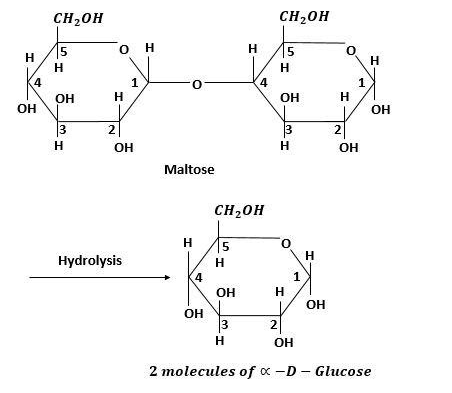
Maltose on treatment with dilute HCl gives:
(A) D-Galactose
(B) D-Glucose
(C) D-Glucose and D-Fructose
(D) D-Fructose
Answer
487.8k+ views
Hint: Reaction with dilute HCl is hydrolysis reaction so hydrolysis of maltose should be done. Hydrolysis is done in the presence of water or dilute acid.
Complete answer:
Reaction of Maltose to glucose is:
Maltose
Monosaccharides units are linked to each other through oxygen atoms by a bond called glycosidic linkage.
One mole of maltose on hydrolysis gives two moles of
Maltose is composed of two

In hydrolysis it breaks at
Additional information: Condensation reaction: It is a reaction in which two molecules combine to form a larger molecule while leaving water or other smaller molecule as a byproduct.
Hydrolysis: It is the chemical breakdown of a compound due to reaction with water.
Monosaccharides: They are simple sugars which contain one oxygen and two hydrogen atoms for each carbon atom present in the compound.
Note: In organic chemistry, reaction with mineral acids like dilute
Complete answer:
Reaction of Maltose to glucose is:
Maltose
Monosaccharides units are linked to each other through oxygen atoms by a bond called glycosidic linkage.
One mole of maltose on hydrolysis gives two moles of
Maltose is composed of two

In hydrolysis it breaks at
Additional information: Condensation reaction: It is a reaction in which two molecules combine to form a larger molecule while leaving water or other smaller molecule as a byproduct.
Hydrolysis: It is the chemical breakdown of a compound due to reaction with water.
Monosaccharides: They are simple sugars which contain one oxygen and two hydrogen atoms for each carbon atom present in the compound.
Note: In organic chemistry, reaction with mineral acids like dilute
Recently Updated Pages
Master Class 4 Maths: Engaging Questions & Answers for Success

Master Class 4 English: Engaging Questions & Answers for Success

Master Class 4 Science: Engaging Questions & Answers for Success

Class 4 Question and Answer - Your Ultimate Solutions Guide

Master Class 11 Economics: Engaging Questions & Answers for Success

Master Class 11 Business Studies: Engaging Questions & Answers for Success

Trending doubts
Give 10 examples of unisexual and bisexual flowers

Draw a labelled sketch of the human eye class 12 physics CBSE

Differentiate between homogeneous and heterogeneous class 12 chemistry CBSE

a Tabulate the differences in the characteristics of class 12 chemistry CBSE

Why is the cell called the structural and functional class 12 biology CBSE

Differentiate between insitu conservation and exsitu class 12 biology CBSE




